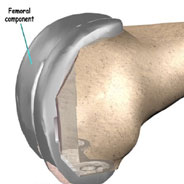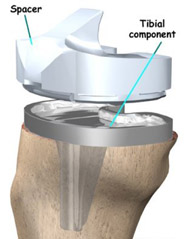

BEFORE

AFTER


FEMUR CUT

FEMORAL COMPONENT

TIBIA CUT

TIBIA TRAY

TIBIA COMPONENTS

TIBIAL COMPONENTS

PATELLA CUTS

PATELLA IMPLANTS

FINAL PICTURE

UNICOMPARTMENT DAMAGE

UNICOMPARTMENTAL KNEE REPLACEMENT
If your knee is severely damaged by arthritis or injury, it may be hard for you to perform simple activities such as walking or climbing stairs. You may even begin to feel pain while you are sitting or lying down. If medications, changing your activity level, and using walking supports are not longer helpful, it is time to consider total knee replacement. By resurfacing your knee's damaged and worn surfaces, total knee replacement can relieve your pain, correct your leg deformity, and help you resume your normal activities.
The knee is the largest joint of the body. Nearly normal knee function is needed to perform routine everyday activities. The most common cause of chronic knee pain and disability is arthritis. Osteoarthritis, rheumatoid arthritis, and traumatic arthritis are the most common forms.
Osteoarthritis usually occurs after the age of 50 and often in an individual with a family history of arthritis. The cartilage that cushions the bones of the knee softens and wears away. The bones then rub against one another causing knee pain and stiffness
Rheumatoid Arthritis is a disease in which the inner lining of the knee becomes thickened and inflamed, producing too much fluid which over-fills the joint space. This chronic inflammation can damage the cartilage and eventually cause cartilage loss, pain and stiffness.
Post Traumatic Arthritis can follow as serious knee injury. A knee fracture or severe tears of the knee's ligaments may damage the particular cartilage over time, causing knee pain and limiting knee function.
The decision whether to have total knee replacement is a cooperative one between you, your family, your family physician, and your orthopaedic surgeon.
Reasons that you may benefit from total knee replacement commonly include:
Most patients who undergo total knee replacement are age 55 to 80, but each patient is evaluated individually. Recommendations for surgery are based on a patient's pain and disability, not age. Patients as young as age 16 and older than 90 have undergone successful total knee replacement.
An important factor in deciding whether to have total knee replacement is understanding what the procedure can and can't do. More than 90 percent of individuals who undergo total knee replacement experience a dramatic reduction of knee pain and a significant improvement in the ability to perform common activities of daily living. But total knee replacement won't make you a super-athlete or allow you to do more than you could before you developed arthritis.
Following surgery, you are advised to avoid some types of activity for the rest of your life, including jogging and high impact sports.
Medical evaluation: if you decide to have total knee replacement, you are asked to have a complete physical by your family physician several weeks before surgery to assess your health and to rule out any conditions that could interfere with your surgery.
Tests: Several tests, such as blood samples, a cardiogram, and a urine sample are done.
Physical therapy: You will begin to practice some of the exercises you'll use after surgery. You'll also be trained in the use of either a walker or crutches.
Preparing Your Skin and Leg: Your knee and leg should not have any skin infections or irritation. Contact your orthopaedic surgeon prior to surgery if either is present for a program to best prepare your skin for surgery.
Blood Donation: You may be advised to arrange for 3-4 units of blood prior to surgery.
Medications: Tell your orthopaedic surgeon about the medications you are taking. He will tell you which medications you should stop taking and which you should continue to take before surgery.
Dental Evaluation: Although the incidence of infection after knee replacement is very low, an infection can occur if bacteria enter your bloodstream. Treatment of significant dental diseases should be considered before your total knee replacement surgery.
Urinary Evaluations: A preoperative urological evaluation should be considered for individuals with a history of recent or frequent urinary infections. For older men with prostate disease, required treatment should be considered prior to knee replacement surgery.
Home Planning Several suggestions can make your home easier to navigate during your recovery. Consider:
You are normally admitted to the hospital a day before the surgery. After admission, you are evaluated by a member of the anesthesia team. The most common types of anesthesia are general anesthesia, in which you are asleep throughout the procedure, and spinal or epidural anesthesia, in which you are awake but your legs are anesthetized. The anesthesia team with your input will determine which type of anesthesia will be best for you.
You can have one or both knees replaced at the same sitting. The usual norm is to replace both knees in the same sitting if both are severely involved and there is no medical contraindication. The damaged cartilage and bone is removed and then new metal and plastic joint surfaces are positioned to restore the alignment and function of the knee. Many different types of designs and materials are currently used in total knee replacement.
After surgery, you are moved to the recovery room, where you will remain for one day while your recovery from anesthesia is monitored. Your hospital room is fumigated and next day you are taken to your room.
You will most likely stay in the hospital for 8-9 days. After surgery, you will feel some pain, but medication will be given to you to make you feel as comfortable as possible. Walking and knee movement are important to your recovery and will begin immediately after your surgery.
Foot and ankle movement is encouraged immediately following surgery to also increase blood flow in your leg muscles to help prevent leg swelling and blood clots. Most patients begin exercising their knee the day after surgery. A physical therapist will teach you specific exercises to strengthen your leg and restore knee movement to allow walking and other normal daily activities soon after your surgery.
The success of your surgery also will depend on how well you follow your orthopaedic surgeon's instructions at home during the first few weeks after surgery.
Wound Care You will have staples running along your wound on the front of your knee. The staples will be removed 2 weeks after surgery. Avoid soaking the wound in water until the wound has thoroughly sealed and dried. A bandage may be placed over the wound to prevent irritation from clothing. Diet Some loss of common appetite is common for several weeks after surgery. A balanced diet, often with an iron supplement, is important to promote proper tissue healing and restore muscle strength.
Activity Exercise is a critical component of home care, particularly during the first few weeks after surgery. You should be able to resume most normal activities of daily living within three to six weeks following surgery. Some pain with activity and at night is common for several weeks after surgery. Your activity program should include:
Driving usually begins when your knee bends sufficiently so you can enter and sit comfortably in your car and when your muscle control provides adequate reaction time for braking and acceleration. Most individuals resume driving about four to six weeks after surgery.
You may feel some numbness in the skin around your incision. You also may feel some stiffness, particularly with excessive bending activities. Improvement of knee motion is a goal of total knee replacement, but restoration of full motion is uncommon. The motion of your knee replacement after surgery is predicted by the motion of your knee prior to surgery. Most patients can expect to nearly fully straighten the replaced knee and to bend the knee sufficiently to go up and down stairs and get in and out of a car. Kneeling is usually uncomfortable, but it is not harmful. Occasionally, you may feel some soft clicking of the metal and plastic with knee bending or walking. These differences often diminish with the time and most patients find these are minor, compared to the pain and limited function they experienced prior to surgery.
Your new knee may activate metal detectors required for security in airports and some buildings. Tell the security agent about your knee replacement if the alarm is activated.
After surgery, make sure you also do the following:
Most older persons can expect their total knee replacement to last 15 years or more. It will give years of pain-free living that would not have been possible otherwise. Younger knee replacement patients may need a second total knee replacement. Materials and surgical techniques are improving through the efforts of orthopaedists working with engineers and other scientists. The future is bright for those who choose to have a total knee replacement to achieve an improved quality of life through greater independence and healthier pain-free activity.